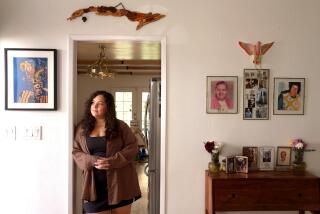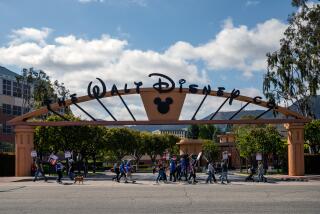Disney Goes Intern-Shopping
- Share via
The bubbly, blue-eyed college freshman wasn’t sure how a Disneyland internship would fit in with her primary field of study, psychology. But then, the Cinderella wannabe attending a recent Cal State Fullerton job fair didn’t much care.
“It’s been a lifelong dream to work at Disneyland,” said Chelsea Rook, 18, who was seeking a seasonal service post at the park. “Any way I could get in the door would work. If the internship turned into a full-time job, even better.”
Faced with the perennial challenge of filling about 4,000 jobs for its busiest season, the Anaheim theme park has turned to a staple of white-collar industry -- the summer internship -- to lure young people such as Rook amid stiff competition from other low-paying service jobs.
In the 1960s and ‘70s, Disneyland didn’t advertise summer jobs. An oversupply of teens and college students lined up for a shot at operating a ride or selling cotton candy.
But as the resort added California Adventure, three hotels and Downtown Disney in recent years, its staff has quadrupled to about 20,000. Meanwhile, the pool of summer job candidates has shrunk because of low unemployment rates.
Disneyland has been forced to recruit more creatively and aggressively. This year, for the first time, the resort is offering internships that allow students to earn college credit for working, and taking courses, at the park, according to guidelines by an accrediting organization.
Interns can earn up to six credits for seven months of work and up to three credits by attending eight-week marketing and leadership classes taught by Disney.
In coming weeks, Disney recruiters will visit about 50 colleges and universities in Southern California. About 200 students will be accepted into the first intern class, which runs from May to December. About three dozen have been chosen already.
Patterned after a successful program at Florida’s Walt Disney World, Disneyland’s internship is unique among Southern California’s biggest theme parks, all of which struggle to fill summer openings.
When Disneyland recruiters sell their new program to candidates, they point to several Disney World interns who turned summer jobs into careers in Disney management. Gary Maggetti, Disneyland’s food and beverage manager, began as a Jungle Cruise skipper during his sophomore year as a Northern Arizona University student.
“The college program was perfect for me,” Maggetti said. “I got exposure to all the intricacies of the resort, and I learned a lot about guest service and problem solving.”
Disneyland interns will earn $8.20 to $10 an hour for what the company describes as “front-line roles” in retail, ride and food jobs. Candidates must agree to work 24 hours a week, including weekends, during non-peak times, and 30 to 40 hours a week during peak periods.
The objective of seasonal employment has evolved as the post-college job market has become more competitive, said Jamie O’Boyle, a theme park scholar at the Center for Cultural Studies & Analysis in Philadelphia.
“In the 1960s, the idea was to get your high school or college kid a job to give them some responsibility and keep them off the street,” O’Boyle said. “Disney is basically saying ... they can offer a good reference at another company or a chance to work your way up the ladder there.”
At last week’s Cal State Fullerton job fair -- attended by about 5,000 students -- Disney competed for talent with about 250 employers, at least half of whom were also offering internships.
“In order to really attract the career-oriented students, it’s not enough anymore to just say ‘We’re Disney,’ ” said Jim Case, director of the university’s career center. “All of these companies are looking for the same profile: problem solvers, good communicators and strong work ethic. So Disney has realized it has to offer something more to be competitive.”
Reactions to Disney’s initial pitch to interns varied widely among students who wandered by the booth, which featured pictures of Mickey Mouse, Mary Poppins and Snow White.
Brittany Johnson, a 20-year-old sophomore from Laguna Hills, said she was hoping for something more than a job loading kids onto rides.
“It seems as though they’re offering lower-level positions,” said Johnson, a culinary arts major. “I’d like to see a program that offered more from the start, something more career-related.”
Thomas Ashdown, a 21-year-old senior communications major from El Cajon, wasn’t interested in earning college credits. He was more interested in the potential long-term benefits.
“Disney is a pretty well-regarded company,” said Ashdown, wearing a dark business suit and carrying a stack of resumes. “The experience of working there will be worth a lot more than what they pay you.”
Said Lorel Roehl, Disneyland’s casting director: “This program helps us cast a wider net. It makes us more competitive in the industry. We do believe we’ll get a highly qualified person from areas we’ve haven’t been able to tap into before.”
*
(BEGIN TEXT OF INFOBOX)
Working for the mouse
*
Disneyland employed 1,300 people in 1955, the year the park opened. Today, about 20,000 people work within the Disney Resort, which covers hotels, part of Downtown Disney and both theme parks.
*
Disney Resort employment
Estimated by decade
1955--1,300
1975--6,000
1985--7,000
1995---12,000
2005---20,000
*
NOTE: Figure for 1965 is unavailabe
Source:Disney Resort. Graphics reporting by David McKibben
More to Read
Inside the business of entertainment
The Wide Shot brings you news, analysis and insights on everything from streaming wars to production — and what it all means for the future.
You may occasionally receive promotional content from the Los Angeles Times.










